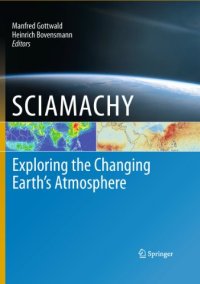
Ebook: SCIAMACHY - Exploring the Changing Earth’s Atmosphere
- Genre: Geography // Meteorology; Climatology
- Tags: Meteorology/Climatology, Climate Change, Astronomy Astrophysics and Cosmology
- Year: 2011
- Publisher: Springer Netherlands
- Edition: 1
- Language: English
- pdf
SCIAMACHY, the SCanning Imaging Absorption spectroMeter for Atmospheric CHartographY, is a passive sensor for exploring the Earth’s atmosphere. It is part of the payload of the European Earth Observation mission ENVISAT, launched on 1 March 2002. SCIAMACHY observes absorption spectra of molecules from the UV (214 nm) to the short-wave infrared wavelength range (2386 nm) and derives the atmospheric composition – trace gases, aerosols, clouds – from these measurements. Having meanwhile successfully monitored and explored the Earth’s atmosphere for more than 8 years, new and exciting insights into the Earth-atmosphere system are obtained. The provided global data sets do not only cover greenhouse gases and pollutants in the troposphere or the ozone chemistry in the stratosphere but even reach up to the mesosphere and lower thermosphere. They contribute significantly to atmospheric physics and chemistry as well as climate change research.
SCIAMACHY is one of the major current Earth Observation undertakings of Germany, The Netherlands and Belgium, accomplished in cooperation with the European Space Agency (ESA). Many scientific groups at various institutes in Europe and abroad were and are actively involved in the analysis of the data.
This book is a comprehensive summary describing the entire SCIAMACHY mission – from the very first ideas to the current results. It illustrates how the measurements are performed, how the trace gas concentrations are derived from the measured spectra and how the unique data sets are used to improve our understanding of the changing Earth’s atmosphere. The targeted readership is not only the existing and potentially new SCIAMACHY data users from undergraduate student level up to researchers new in the fields of atmospheric chemistry and remote sensing, but anyone who is keen to learn about SCIAMACHY’s efforts to study the atmosphere and its responses to both, natural phenomena and anthropogenic effects.
SCIAMACHY, the SCanning Imaging Absorption spectroMeter for Atmospheric CHartographY, is a passive sensor for exploring the Earth’s atmosphere. It is part of the payload of the European Earth Observation mission ENVISAT, launched on 1 March 2002. SCIAMACHY observes absorption spectra of molecules from the UV (214 nm) to the short-wave infrared wavelength range (2386 nm) and derives the atmospheric composition – trace gases, aerosols, clouds – from these measurements. Having meanwhile successfully monitored and explored the Earth’s atmosphere for more than 8 years, new and exciting insights into the Earth-atmosphere system are obtained. The provided global data sets do not only cover greenhouse gases and pollutants in the troposphere or the ozone chemistry in the stratosphere but even reach up to the mesosphere and lower thermosphere. They contribute significantly to atmospheric physics and chemistry as well as climate change research.SCIAMACHY is one of the major current Earth Observation undertakings of Germany, The Netherlands and Belgium, accomplished in cooperation with the European Space Agency (ESA). Many scientific groups at various institutes in Europe and abroad were and are actively involved in the analysis of the data.This book is a comprehensive summary describing the entire SCIAMACHY mission – from the very first ideas to the current results. It illustrates how the measurements are performed, how the trace gas concentrations are derived from the measured spectra and how the unique data sets are used to improve our understanding of the changing Earth’s atmosphere. The targeted readership is not only the existing and potentially new SCIAMACHY data users from undergraduate student level up to researchers new in the fields of atmospheric chemistry and remote sensing, but anyone who is keen to learn about SCIAMACHY’s efforts to study the atmosphere and its responses to both, natural phenomena and anthropogenic effects.